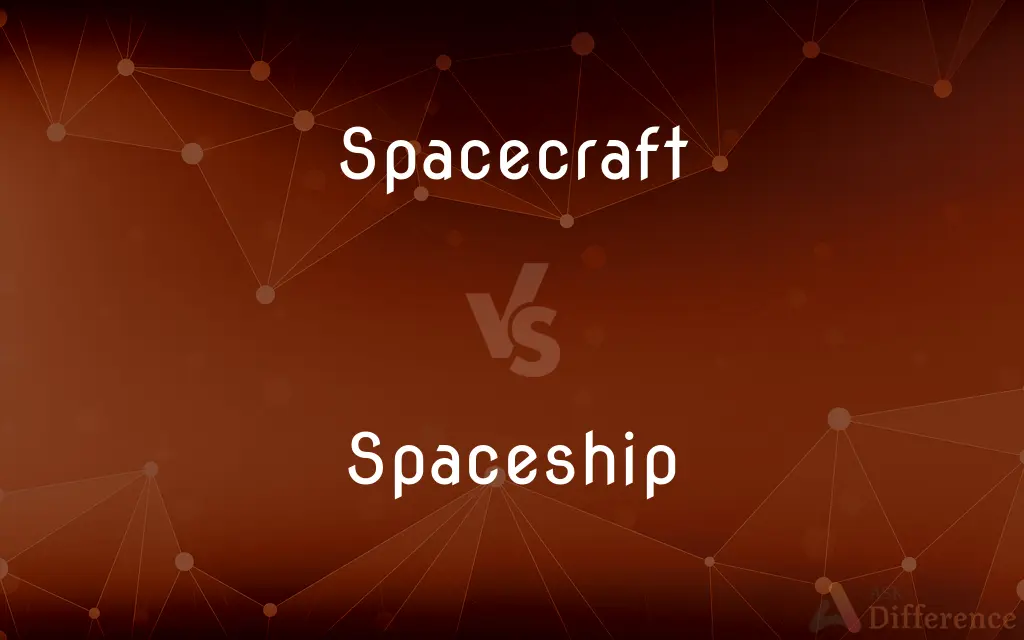Spacecraft vs. Spaceship — What's the Difference?
By Tayyaba Rehman & Fiza Rafique — Updated on March 18, 2024
Spacecraft are vehicles designed for space travel, while spaceships specifically refer to those capable of carrying humans through space.

Difference Between Spacecraft and Spaceship
Table of Contents
ADVERTISEMENT
Key Differences
Spacecraft is a broad term that encompasses any vehicle designed for space travel, including satellites, probes, rovers, and crewed vessels. Spaceships, however, are a subset of spacecraft specifically designed to transport humans through outer space.
While all spaceships are spacecraft, not all spacecraft are spaceships. This distinction highlights the spaceship's role in manned space exploration missions, compared to other spacecraft intended for research, communication, or observation purposes.
Spacecraft can be designed for a variety of missions, such as orbiting Earth, exploring other planets, or observing distant cosmic phenomena. Spaceships are primarily focused on supporting human life and activity in space, including travel to the International Space Station, the Moon, or potentially other planets in the future.
The design and technology of spacecraft vary widely depending on their intended function. They might not require systems to support human life if they are unmanned. Spaceships, however, must be equipped with life support systems, crew habitats, and safety mechanisms to protect and sustain astronauts.
Examples of spacecraft include the Hubble Space Telescope, the Mars Rover, and communication satellites. Spaceships include the Space Shuttle, Soyuz capsules, and the SpaceX Crew Dragon.
ADVERTISEMENT
Comparison Chart
Definition
Vehicles designed for space travel.
A subset of spacecraft capable of carrying humans.
Composition
Includes satellites, probes, rovers, and crewed vessels.
Primarily crewed vessels.
Purpose
Varied missions including research, communication, and exploration.
Human space exploration and travel.
Design Requirements
Depends on mission; may not require life support systems.
Must include life support systems and crew habitats.
Examples
Hubble Space Telescope, Mars Rover, communication satellites.
Space Shuttle, Soyuz capsules, SpaceX Crew Dragon.
Compare with Definitions
Spacecraft
Designed for specific missions.
The spacecraft carried instruments to analyze the Martian atmosphere.
Spaceship
A spacecraft designed to carry humans.
The new spaceship is being tested for crewed missions to Mars.
Spacecraft
Varied in size and capabilities.
Small spacecraft can play a big role in Earth observation.
Spaceship
Used for human space exploration.
The spaceship docked with the International Space Station for a resupply mission.
Spacecraft
Can be unmanned or crewed.
NASA's latest spacecraft is an unmanned probe designed to study the outer planets.
Spaceship
Includes crew habitats and safety features.
The spaceship's design prioritizes crew safety and comfort for long-duration flights.
Spacecraft
Any vehicle designed for space travel.
The spacecraft Voyager 1 has entered interstellar space, sending back invaluable data.
Spaceship
Equipped with life support systems.
The spaceship's life support systems are designed to sustain the crew for up to six months.
Spacecraft
Does not require life support if unmanned.
The spacecraft orbiting Jupiter is automated and operates remotely.
Spaceship
Represents a subset of spacecraft.
Spaceships are a crucial part of our expanding capabilities in manned spaceflight.
Spacecraft
A spacecraft is a vehicle or machine designed to fly in outer space. A type of artificial satellite, spacecraft are used for a variety of purposes, including communications, Earth observation, meteorology, navigation, space colonization, planetary exploration, and transportation of humans and cargo.
Spaceship
A spacecraft, especially one controlled by a crew.
Spacecraft
A vehicle designed to be launched into space. Also called spaceship.
Spaceship
See spacecraft.
Spacecraft
A vehicle that travels through space.
Spaceship
(astronautics) A vehicle that flies through space.
Spacecraft
A vehicle capable of travelling in or into outer space; at present, all such vehicles are powered by rocket engine.
Spaceship
A finite pattern that reappears after a certain number of generations in the same orientation but in a different position.
Spacecraft
A craft capable of traveling in outer space; technically, a satellite around the sun
Spaceship
(programming) The operator
<=> in certain programming languages, which compares two values and indicates whether the first is lesser than, greater than, or equal to the second.Spaceship
A spacecraft designed to carry a crew into interstellar space (especially in science fiction)
Common Curiosities
What advancements are being made in spaceship technology?
Current advancements include reusable spacecraft, improved life support systems, more efficient propulsion technologies, and designs for longer missions, such as those to Mars.
Why are unmanned spacecraft still important if we have spaceships?
Unmanned spacecraft can go to environments too dangerous for humans, operate for extended periods, and perform specific scientific tasks at a lower cost and risk than crewed missions.
How do spaceships support human life in space?
Spaceships are equipped with life support systems that provide air, water, and food, control temperature, and manage waste to support human life during space missions.
Can a satellite be considered a spaceship?
No, a satellite is a type of spacecraft typically used for communication, observation, or navigation purposes and does not carry humans, thus not fitting the definition of a spaceship.
What's the future of spaceships and space exploration?
The future includes plans for manned missions to Mars, the development of space habitats, commercial space travel, and further exploration of the solar system and beyond.
Can spaceships travel faster than the speed of light?
Currently, spaceships cannot travel faster than the speed of light. Theoretical concepts like the warp drive exist but are far from practical application due to current scientific and technological limitations.
Are all spaceships designed to land on other planets?
Not all spaceships are designed for planetary landings. Some are meant for travel or work in orbit, such as transporting astronauts to the International Space Station.
How are spaceships protected from space debris and micrometeoroids?
Spaceships are equipped with shielding to protect against space debris and micrometeoroids. Techniques include Whipple shields, which are multiple layers of material that disperse the energy of impacting particles.
What is the longest duration a human has spent on a spaceship?
The longest continuous human spaceflight record is held by Valeri Polyakov, who spent nearly 438 days aboard the Mir space station from 1994 to 1995. This showcases the capability of spaceships to support long-duration missions.
How do astronauts train for space missions on spaceships?
Astronauts undergo extensive training in simulators that mimic the spaceship's environment, learning how to operate the spacecraft, conduct repairs, and handle emergencies.
What role do international collaborations play in developing spaceships?
International collaborations allow for the sharing of technology, resources, and expertise, significantly advancing spaceship development and making space exploration more feasible and cost-effective.
How do spaceships communicate with Earth?
Spaceships communicate with Earth using radio waves transmitted through space antennas and ground-based antennas. The Deep Space Network is an example of a communication system used to maintain contact with spacecraft beyond Earth's orbit.
Share Your Discovery

Previous Comparison
Horrifying vs. Terrifying
Next Comparison
Accountable vs. ReliableAuthor Spotlight
Written by
Tayyaba RehmanTayyaba Rehman is a distinguished writer, currently serving as a primary contributor to askdifference.com. As a researcher in semantics and etymology, Tayyaba's passion for the complexity of languages and their distinctions has found a perfect home on the platform. Tayyaba delves into the intricacies of language, distinguishing between commonly confused words and phrases, thereby providing clarity for readers worldwide.
Co-written by
Fiza RafiqueFiza Rafique is a skilled content writer at AskDifference.com, where she meticulously refines and enhances written pieces. Drawing from her vast editorial expertise, Fiza ensures clarity, accuracy, and precision in every article. Passionate about language, she continually seeks to elevate the quality of content for readers worldwide.














































